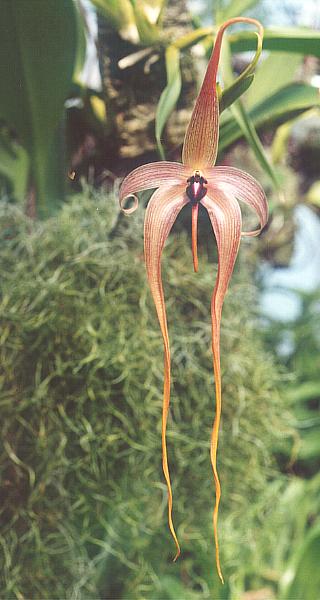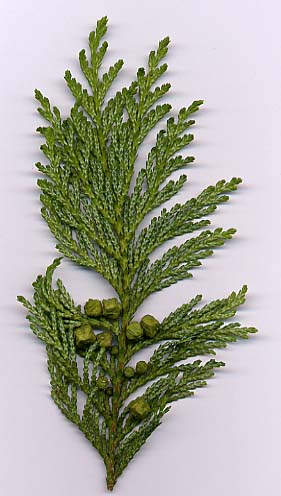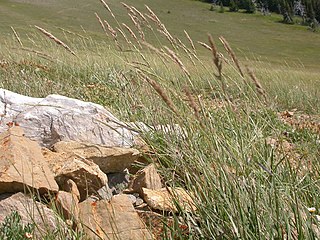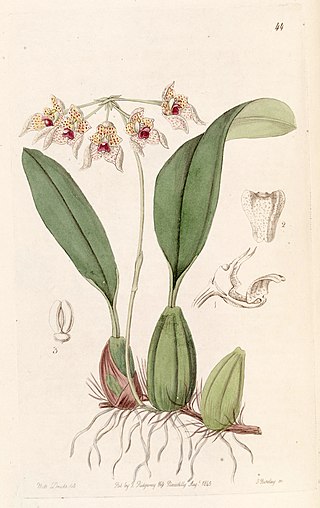
Bulbophyllum is a genus of mostly epiphytic and lithophytic orchids in the family Orchidaceae. It is the largest genus in the orchid family and one of the largest genera of flowering plants with more than 2,000 species, exceeded in number only by Astragalus. These orchids are found in diverse habitats throughout most of the warmer parts of the world including Africa, southern Asia, Latin America, the West Indies, and various islands in the Indian and Pacific Oceans. Orchids in this genus have thread-like or fibrous roots that creep over the surface of trees or rocks or hang from branches. The stem is divided into a rhizome and a pseudobulb, a feature that distinguished this genus from Dendrobium. There is usually only a single leaf at the top of the pseudobulb and from one to many flowers are arranged along an unbranched flowering stem that arises from the base of the pseudobulb. Several attempts have been made to separate Bulbophyllum into smaller genera, but most have not been accepted by the World Checklist of Selected Plant Families.

The International Plant Names Index (IPNI) describes itself as "a database of the names and associated basic bibliographical details of seed plants, ferns and lycophytes." Coverage of plant names is best at the rank of species and genus. It includes basic bibliographical details associated with the names. Its goals include eliminating the need for repeated reference to primary sources for basic bibliographic information about plant names.

Chamaecyparis, common names cypress or false cypress, is a genus of conifers in the cypress family Cupressaceae, native to eastern Asia and to the western and eastern margins of the United States. The name is derived from the Greek khamai (χαμαί), meaning "on the earth", and kuparissos (κυπάρισσος) for "cypress".

Calamagrostis purpurascens, is a perennial grass commonly known as purple reedgrass, purple pinegrass, or alpine reedgrass.

Vachellia farnesiana, also known as Acacia farnesiana, and previously Mimosa farnesiana, commonly known as sweet acacia, huisache, or needle bush, is a species of shrub or small tree in the legume family, Fabaceae. Its flowers are used in the perfume industry.
Bulbophyllum bifarium, or two-sided bulbophyllum, is an epiphytic plant species in the family Orchidaceae, flowering in November and endemic to Cameroon. Its natural habitats are subtropical or tropical moist lowland forests and subtropical or tropical moist montane forests, where it is threatened by habitat loss. It was described in 1864 by Joseph Dalton Hooker.
Bulbophyllum gravidum is a species of epiphytic plant in the family Orchidaceae that is found in Equatorial Guinea and Cameroon. Its natural habitats are in montane, subtropical or tropical dry forests, at elevations of about 1,500 meters. The Mount Cameroon habitat, in particular, is threatened by the clearing of forest for the purpose of cocoyam farming.
Bulbophyllum jaapii is a species of plant in the family Orchidaceae. It is endemic to Cameroon. Its natural habitat is subtropical or tropical moist montane forests. It was described botanically in 2001.
Bulbophyllum modicum is a possibly extinct, epiphytic plant species in the family Orchidaceae. It is endemic to Cameroon, and its natural habitat is threatened. It was described in 1957.
Bulbophyllum nigericum is an epiphytic or epilithic plant species in the family Orchidaceae. It is native to Cameroon, and Nigeria, where it is found growing habitually in submontane and montane, tropical or subtropical, moist forest, at elevations roughly between 800 and 2,050 meters. It is threatened by habitat loss due to continued, extensive forest clearance for the purpose of crop cultivation. It was described in 1962.
Bulbophyllum pandanetorum is a rare species of epiphytic plant in the family Orchidaceae. It is found in Cameroon and Gabon, where its natural habitat is subtropical or tropical moist lowland forests at elevations roughly between 200 and 950 meters. It is threatened by habitat loss. It was botanically described in 1954.
Bulbophyllum porphyrostachys is a species of plant in the family Orchidaceae. It is found in Cameroon, the Republic of the Congo, and Nigeria. It was botanically described in 1951.
Bulbophyllum tokioi is a species of plant in the family Orchidaceae. It is endemic to Taiwan. It was described in 1935 by Noriaki Fukuyama.

Prunus campanulata is a species of cherry native to Japan, Taiwan, southern and eastern China, and Vietnam. It is a large shrub or small tree, growing 3–8 m (10–26 ft) tall. It is widely grown as an ornamental tree, and a symbol of Nago in the Ryukyu Islands of Japan. It is variously known in English as the Taiwan cherry, Formosan cherry, or bellflower cherry. It was described in 1883 by Carl Johann Maximowicz.

Ribes divaricatum is a species in the genus Ribes found in the forests, woodlands, and coastal scrub of western North America from British Columbia to California. The three accepted varieties have various common names which include the word "gooseberry". Other common names include coast black gooseberry, wild gooseberry, Worcesterberry, or spreading-branched gooseberry.

Bulbophyllum umbellatum is a species of orchid. It is native to tropical parts of South Asia, from the west central Himalayas to Taiwan and Indo-China.

Bulbophyllum muscicola is a species of orchid in the genus Bulbophyllum. It is native to the eastern Himalayan region, and the Asian tropics.

Cupressus arizonica var. glabra, known as the Arizona smooth bark cypress or smooth Arizona cypress, is a conifer native to the American Southwest, with a range stretching over the canyons and slopes in a somewhat wide vicinity around Sedona, Arizona. It was first described by George Bishop Sudworth in 1910.

Ribes cereum is a species of currant known by the common names wax currant and squaw currant; the pedicellare variety is known as whisky currant. The species is native to western North America.

Lumnitzera racemosa, commonly known as the white-flowered black mangrove, is a species of mangrove in the family Combretaceae. It is found on the eastern coast of Africa and other places in the western Indo-Pacific region. It has one accepted variety from the noniminate species, Lumnitzera racemosa var. lutea (Gaudich.) Exell.












